Seasonality of Individual Stocks
We talk a lot about seasonality in our work. In general, seasonality is some repeatable tendency for a financial instrument to move relative to some influencing factor. That factor could be the time of year, the year of a decade, changes in interest rates, inflation, etc.
One thing we always say is that seasonal cycles do not cause prices to move a certain way. They simply reflect a measure of tendency. Ongoing price action is influenced by many factors, only some of which occur on a regular, repeated basis.
This discussion will focus on stock price action and seasonal cycles derived from the time of the year. Over the course of the year, a stock may show tendencies to have strong or weak price action, time and again, one year to the next. To understand how we determine this, let's consider the 15-year price chart of GM – General Motors Corp:
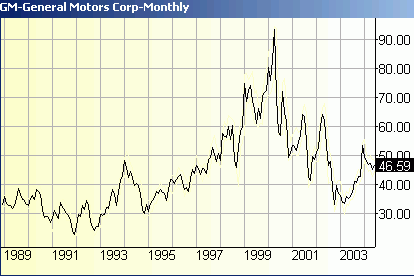
If we chop up this chart so that we see each year super-imposed over each other on a January to December scale, this is what we would see:
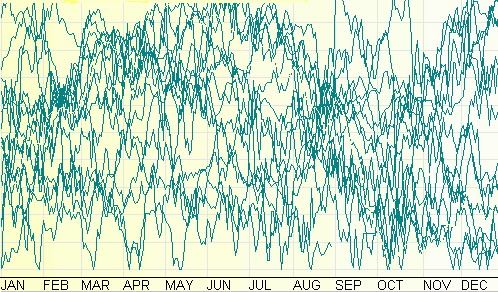
At first, it would appear that there is no discernable pattern in the above “mess.” However, the composite of the above data does yield a distinct pattern:
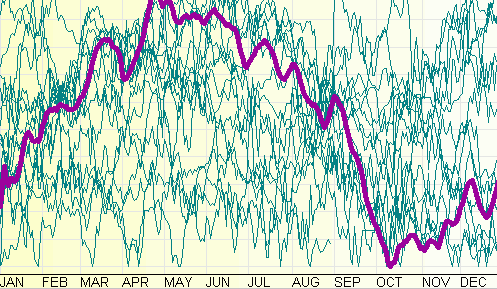
Now the question becomes: does this “seasonal” pattern reflect tendencies throughout the 15-year history of GM, or is it a random cycle? To answer this question, we must create two similar seasonal composites, one from the first half of GM's 15-year history (1988 to 1995), and one from the second half of GM's 15-year history (1996 to 2003.) We only use complete years in constructing seasonal cycles. We will eliminate plotting the chopped up years of GM, and now show 3 seasonal cycles:
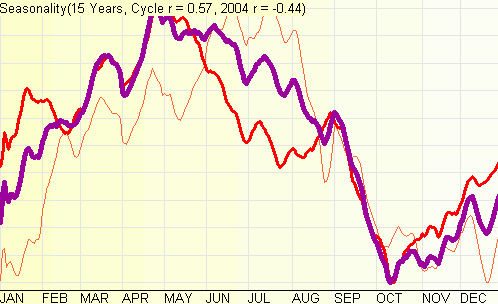
The thin red line above is the seasonal cycle for GM based on years 1988 through 1995. The thick red line is the seasonal cycle for GM based on years 1996 through 2003. These thick purple line is the seasonal cycle based on all 15 years of GM price history. All these cycles bear similarities, especially at certain times of the year (the low point in October, for instance.)
We can use a correlation statistic called Pearson's R. Pearson's R is a statistical expression of linear relationship between two variables. It ranges from +1 to -1, with a reading of +1 being a perfect match between two variables. A reading of -1 indicates a perfectly inverse relationship between two variables, while a reading of 0 implies no relationship, or correlation at all between the two variables. In the chart above in the caption is a Cycle r statistic. This is the Pearson's R of two variables, the seasonal cycle for GM based on years 1988 through 1995 (thin red line) and the seasonal cycle for GM based on years 1996 through 2003 (thick red line.) In this case the Cycle r equals 0.57, a strong correlation. Our conclusion from this is that the yearly cycle derived from the entire 15-year history (purple line) does indeed reflect strong seasonal tendencies. Now the task is to see how recent activity matches up with this seasonal cycle:
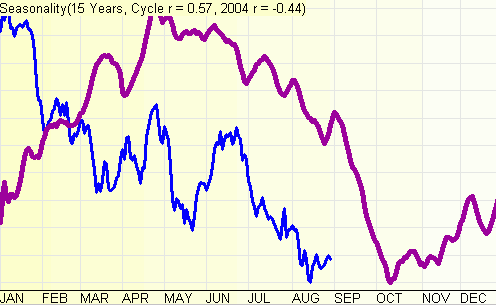
The above chart shows the 15-year seasonal cycle for GM (purple line.) The blue line is the normalized price action of GM this year (August 27, 2004.) At the top of the chart in the caption is a 2004 r statistic. This measures the Pearson's R of the action so far this year (2004) relative to the 15-year seasonal cycle. It is at -0.44, a reading which suggests that GM has deviated substantially from its normal seasonal cycle. By looking at the chart. One can see that GM was weak during the seasonally strong period from January 2004 to May 2004. This gives investors a unique perspective in judging its investment worthiness. The seasonal cycle is extremely weak going into mid October. Those thinking of buying GM should wait to see how GM's price holds up during this period. If price fails to go to a lower low, the 2004 r statistic will still be negative, but the lack of correlation will have reverted from one of weakness to one of strength during a typically weak period for the stock's price. If the 2004 R statistic moves above “0” into October, this would indicate that the stock remains suspect because of continued weakness during a seasonally weak period. In other words, it would have failed to show strength in the face of seasonal adversity.